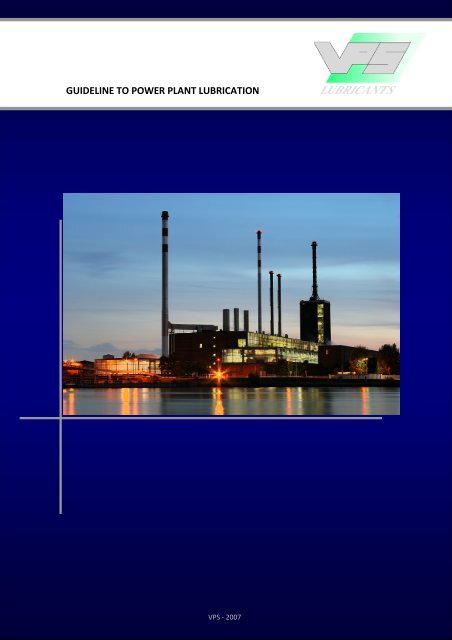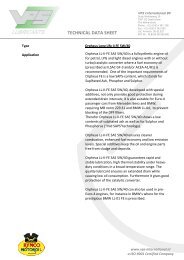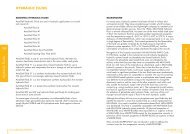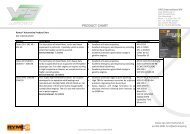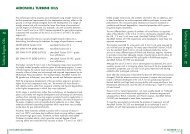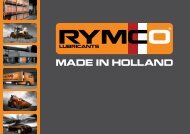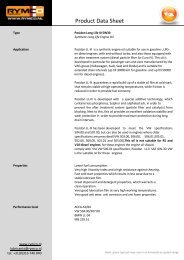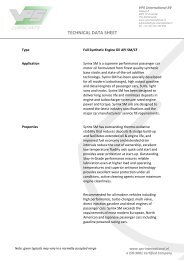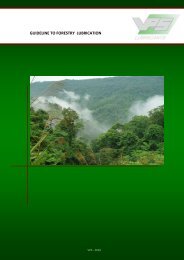GUIDELINE TO POWER PLANT LUBRICATION - VPS Lubricants
GUIDELINE TO POWER PLANT LUBRICATION - VPS Lubricants
GUIDELINE TO POWER PLANT LUBRICATION - VPS Lubricants
Create successful ePaper yourself
Turn your PDF publications into a flip-book with our unique Google optimized e-Paper software.
<strong>GUIDELINE</strong> <strong>TO</strong> <strong>POWER</strong> <strong>PLANT</strong> <strong>LUBRICATION</strong><br />
<strong>VPS</strong> - 2007
<strong>GUIDELINE</strong> <strong>TO</strong> <strong>POWER</strong> <strong>PLANT</strong> <strong>LUBRICATION</strong><br />
Introduction<br />
<strong>Lubricants</strong> used in the power generating industry can be divided into two categories. First there is the<br />
transformer oil with insulating properties. Second there is a range of lubricants suitable for the lubrication of<br />
the machinery generating the energy. These can either be large reciprocating engines or generators requiring<br />
high TBN marine like lubricants, reciprocating gas engines requiring lubricants with a specific ash content or<br />
turbines varying from high performance aviation turbines to smaller hydroelectric units.<br />
Transformer oil<br />
Transformer oil is a highly-refined mineral oil that is stable at high temperatures and has excellent electrical<br />
insulating properties. It is used in oil-filled transformers, some types of high voltage capacitors, fluorescent<br />
lamp ballasts, and some types of high voltage switches and circuit breakers. Its functions are to insulate,<br />
suppress corona and arcing, and to serve as a coolant.<br />
The oil helps cool the transformer. Because it also provides part of the<br />
electrical insulation between internal live parts, transformer oil must<br />
remain stable at high temperatures over an extended period. To<br />
improve cooling of large power transformers, the oil-filled tank may<br />
have external radiators through which the oil circulates by natural<br />
convection. Very large or high-power transformers (with capacities of<br />
millions of watts) may also have cooling fans, oil pumps, and even oilto-water<br />
heat exchangers.<br />
Large, high-voltage transformers undergo prolonged drying processes,<br />
using electrical self-heating, the application of a vacuum, or both to<br />
ensure that the transformer is completely free of water vapor before<br />
Transformer<br />
the cooling oil is introduced. This helps prevent corona formation and subsequent electrical breakdown under<br />
load.<br />
Relevant <strong>VPS</strong> products:<br />
Rymco® Cratos I (Transformer Oil BS 148:1998 Class I)<br />
Rymco® Cratos II (Transformer Oil BS 148:1998 Class I)<br />
Gas Generator & Diesel Engine <strong>Lubricants</strong><br />
Gas Engine oils are high performance, specially inhibited oils for the lubrication of heavy-duty stationary gas<br />
and steam turbines. They are also ideal for lubrication of rotating machinery in combined-cycle cogeneration<br />
units. Incorporating an ashless, low volatility, antioxidant package, they offer excellent oxidation stability, low<br />
deposit forming capabilities in high temperature areas, protect against rust and corrosion, and offer rapid<br />
separation of water and release of entrained air.<br />
For smaller generators with heavy-duty, turbo-charged diesel engines a range of<br />
automotive engine oils can be applied. Different API classifications apply such as<br />
CD for smaller and older generators, CF, CG-4 and CI-4 for newer models with<br />
higher output. For smaller two stroke diesel engines, an API CF-2 is recommended.<br />
Larger Medium Speed Diesel<br />
generators require marine like<br />
Smaller Diesel Generator<br />
lubricants with a high TBN. Mostly in a<br />
monograde SAE 40 with a total base number varying from 6 to 40.<br />
The oils should be compatible with different qualities of residual<br />
fuel, have an excellent thermal and oxidation stability and have a<br />
high load carrying capacity.<br />
Large Diesel Generator<br />
Cylinder Oils are the most high TBN oils in the range (TBN 70). Preventing corrosive wear, avoiding deposit<br />
formation, protecting against scuffing, minimizing piston ring and liner wear, minimizing fuel consumption.<br />
<strong>VPS</strong> International BV – www.vps-international.nl<br />
- 1 -
<strong>GUIDELINE</strong> <strong>TO</strong> <strong>POWER</strong> <strong>PLANT</strong> <strong>LUBRICATION</strong><br />
Relevant <strong>VPS</strong> products:<br />
Rymco® Frya Gaz MA (Medium Ash Gas Engine Oil)<br />
Rymco® Erato M (Mineral Turbine Oil (Group I))<br />
Rymco® Erato S (Mineral Turbine Oil (Group II))<br />
Rymco® Universal HD (CF-4 Engine Oil)<br />
Rymco® Endurox LD (CI-4 Engine Oil)<br />
Rymco® Marlub series (High TBN Monograde Medium Speed Diesel Engine Oils)<br />
Rymco® Marlub Cyn 70 ( TBN 70 cylinder oil)<br />
Turbine Oil<br />
Under normal conditions, the lubricating oil for a hydroelectric unit’s<br />
guide and thrust bearings experiences relatively mild service, but it is<br />
expected to have a long service life. To have a long life, a high quality oil<br />
with various additives to enhance and maintain its quality is required.<br />
In most powerplants, a highly refined turbine oil is used for bearing<br />
lubrication. Table 1 lists some typical properties of a Group I turbine oil.<br />
A Group II oil would have better oxidation stability. The oil should be rust<br />
and oxidation inhibited with an antifoam additive. The oil should also be<br />
resistant to emulsification and separate readily from water. Antiwear or<br />
extreme pressure additives are not<br />
required or desired.<br />
Sulzer Turbine Generator<br />
Relevant <strong>VPS</strong> products:<br />
Rymco® Erato M (Mineral Turbine Oil (Group I))<br />
Rymco® Erato S (Mineral Turbine Oil (Group II))<br />
The recommended oil viscosity is usually<br />
specified by the equipment manufacturer<br />
and depends on the operating speed,<br />
load, and temperature as well as the<br />
Large Turbine Generator<br />
bearing clearances. The most common<br />
viscosities used in turbines are the ISO viscosity grades 32, 46, and 68.<br />
Hydraulic Oil<br />
The primary purpose of hydraulic fluid is to transmit power. To accomplish this effectively, the fluid must be<br />
incompressible and flow readily through the system. The fluid must also have sufficient viscosity to seal and<br />
lubricate the components of the hydraulic system. There are a variety of fluids capable of performing these<br />
functions, but the most satisfactory hydraulic fluid is usually oil.<br />
A hydraulic oil has many of the same requirements as a lubricating oil used<br />
in the unit bearings, and, in many cases, the same oil can be used. If the<br />
system uses a gear pump, operates at pressures less than 1,000 pounds<br />
per square inch (psi), and has similar viscosity requirements, the bearing<br />
lubricating oil can function very well as a hydraulic oil. In systems that<br />
operate over 1,000 psi or use a piston or sliding vane pump, a fluid with an<br />
antiwear additive is usually required. Where the system operates in an<br />
area of great temperature extremes, a multigrade oil may be required to<br />
provide desirable high and low temperature viscosity characteristics.<br />
Hydraulic System<br />
In some instances, a fire-resistant hydraulic fluid may be required. These<br />
fluids are usually either a water-based or a synthetic fluid. In either case, the system must be designed<br />
specifically for the fluid it will use. Water-based fluids have a very low viscosity, and the synthetic fluids are not<br />
compatible with many seal materials found in hydraulic systems.<br />
<strong>VPS</strong> International BV – www.vps-international.nl<br />
- 2 -
<strong>GUIDELINE</strong> <strong>TO</strong> <strong>POWER</strong> <strong>PLANT</strong> <strong>LUBRICATION</strong><br />
Relevant <strong>VPS</strong> products:<br />
Rymco® Hydra AW (HLP Hydraulic fluids in a range of ISO grades)<br />
Rymco® Hydra HVI (HVI Hydraulic fluids in a range of ISO grades)<br />
Grease<br />
Grease for the slow moving, highly loaded, bronze bushings such as those found on wicket gates, radial gates,<br />
and butterfly valves should be adhesive, water resistant, able to withstand high bearing pressures, and of a<br />
consistency that can be pumped at the lowest temperature encountered. Usually, a<br />
grease with extreme pressure or antiwear capabilities is specified. It should be noted<br />
that the term, “extreme pressure,” is used fairly liberally by grease manufacturers,<br />
and the presence of extreme pressure additives and extreme pressure properties<br />
should be verified. Because the grease is lubricating a bronze bearing, it should not<br />
be corrosive to copper. The dropping point of the grease has little relevance in this<br />
Ball Bearing case.<br />
Relevant <strong>VPS</strong> products:<br />
Caldax (Calcium Grease)<br />
Caldax GR (Calcium & Graphite Grease)<br />
Caldax SI (Calcium Silicon Grease)<br />
Comdax 2 (Lithium Complex Grease)<br />
Lindax EP1-2-3 (Lithium Grease EP)<br />
Lindax MP2-3 (Lithium Grease MP)<br />
Moldax 2 (MoS2 Grease)<br />
Interior of a Powerhouse<br />
Gear Oil<br />
Gears vary greatly in design and in their requirements for lubrication. When selecting a lubricant for any gear<br />
application, the type of gearing and the operating conditions, such as speed, load, and temperature, must be<br />
considered. Enclosed gears (i.e., gears encased in an oil tight housing)<br />
usually use a mineral oil with rust, oxidation, and foam inhibitors and,<br />
where loads are severe, extreme pressure additives.<br />
Worm gears are a special case because the action between the worm and<br />
its mating gear is sliding rather than the rolling action found in most gears.<br />
The sliding action allows fluid film lubrication to take place. Worm gears<br />
are also different in that the mating gears (the worm and the bull gears)<br />
are usually made of dissimilar materials. The use of dissimilar material<br />
reduces the friction and the chance of galling. Extreme pressure additives<br />
are usually not required for worm gears, but lubrication can be improved<br />
by lubricity additives.<br />
A highly adhesive lubricant is required for most<br />
open gear applications. An open gear lubricant<br />
must resist being thrown off by centrifugal force or<br />
being scraped off by the action of the gear teeth.<br />
Most open gear lubricants are heavy oils, many<br />
times asphalt based, or soft greases. Depending on<br />
the service conditions, oxidation inhibitors or<br />
extreme pressure additives may be added.<br />
Worm Gear<br />
Because these lubricants are very adhesive, they<br />
also attract dust and dirt. These contaminants can act as abrasives if the<br />
gears are not periodically cleaned.<br />
Closed Gear<br />
Open Gear<br />
<strong>VPS</strong> International BV – www.vps-international.nl<br />
- 3 -
<strong>GUIDELINE</strong> <strong>TO</strong> <strong>POWER</strong> <strong>PLANT</strong> <strong>LUBRICATION</strong><br />
Relevant <strong>VPS</strong> products:<br />
Rymco® Gevitro TWS (Mineral Industrial Gear Oil in a variety of ISO Grades)<br />
Rymco® Gevitro TWS FS (Full synthetic PAO Industrial Gear Oil in a variety of ISO Grades)<br />
Wire Rope Lubricant<br />
The life of a wire rope can be extended through the proper application of the correct lubricant. The individual<br />
wires in a wire rope are subject to abrasive wear as they move relative to each other any time the rope is bent,<br />
such as when it goes over a sheave or is wound on a drum. Unless the rope is<br />
constructed of stainless steel, it is also subject to corrosion damage. Corrosion is<br />
especially a problem for wire ropes that are exposed to the elements.<br />
To be effective, the lubricant must penetrate into the rope to provide lubrication<br />
between the individual wires and strands. It also must provide lubrication externally<br />
to reduce friction between the rope and sheaves or drum, and it should act as a<br />
sealant to prevent corrosion. The lubricant coating should not prevent the visual<br />
inspection of the rope for broken wires or other damage.<br />
Many times, a light mineral oil, such as an SAE<br />
Samples of WIre Ropes 10 motor oil, is used to lubricate wire rope.<br />
The advantages of such a light oil is that it can<br />
be applied cold and it will penetrate into the rope easily. The main<br />
disadvantage is that it will work out of the rope just as easily as it works<br />
in, and frequent application will be required.<br />
Heavy, adhesive lubricants can provide longer lasting protection, but<br />
most require heating before application to provide proper penetration.<br />
A heavy lubricant, when properly applied, will not only provide internal<br />
lubrication, but also provide a durable outer coating to prevent<br />
corrosion and keep dust and abrasives out of the rope. Heavy adhesive<br />
lubricants usually must be heated or thinned with a solvent to ensure<br />
they provide internal lubrication.<br />
Large WIre Rope Application<br />
Relevant <strong>VPS</strong> products:<br />
Rymco® Hydra HD SAE 10W<br />
Matrix® Grease Calcium Graphite RW<br />
Disclaimer: Technical experiences on site may differ from theoretical advice. When visiting or contacting a site, please always verify the products that<br />
are currently used. This guideline is not ment to be a fixed recommendation. Fixed recommentations can only be made after inpecting the products<br />
that are currently used as well as a close look at the application and its circumstances.<br />
<strong>VPS</strong> International BV – www.vps-international.nl<br />
- 4 -


